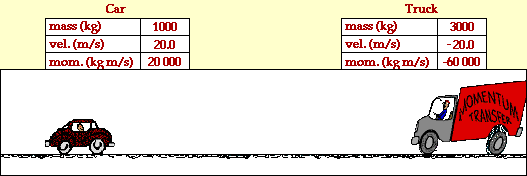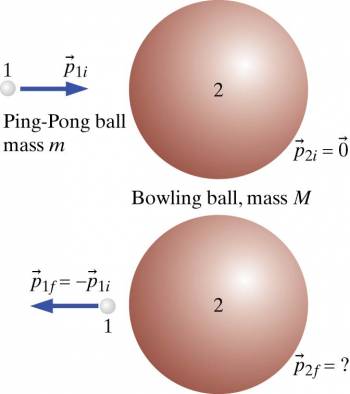Head-on Collision of Unequal Masses: Difference between revisions
| Line 12: | Line 12: | ||
If the equation is inelastic, the idea of conservation of momentum can be used because momentum is always conserved in collisions. The equation for the conservation of momentum is: <math>m_1v_1i^2 + m_2v_2i^2 = m_1v_1f^2 + m_2v_2f^2</math> | If the equation is inelastic, the idea of conservation of momentum can be used because momentum is always conserved in collisions. The equation for the conservation of momentum is: <math>m_1v_1i^2 + m_2v_2i^2 = m_1v_1f^2 + m_2v_2f^2</math> | ||
Let's talk about a specific example to truly understand what happens in a head-on collision of unequal masses. As referenced to before, the ping pong and bowling ball example clearly expresses what happens. Assuming the bowling ball is at rest when the ping pong ball hits it, the final momentum of the bowling ball is twice the initial momentum of the ping pong ball. Using the momentum principle, | [[File:Ping pong bowling ball.jpg]] | ||
Let's talk about a specific example to truly understand what happens in a head-on collision of unequal masses. As referenced to before, the ping pong and bowling ball example clearly expresses what happens. Assuming the bowling ball is at rest when the ping pong ball hits it, the final momentum of the bowling ball is twice the initial momentum of the ping pong ball. Using the momentum principle, | |||
===A Computational Model=== | ===A Computational Model=== | ||
Revision as of 16:01, 27 November 2015
Main Idea
The two main types of collisions are Elastic Collisions and Inelastic Collisions, but these are very broad as there are many much more specific types of collisions under these umbrella terms. One of the specific types of collisions is head-on collisions of unequal masses. This is exactly what it sounds like - two objects of different masses collide with each other head-on, and this causes some changes in kinetic energy and speed. This can be thought of as two different types of cars colliding with each other, but to make the visualization a bit easier, think about a ping pong ball colliding with a bowling ball.
 Elastic head-on collision between a car and truck[1]
Elastic head-on collision between a car and truck[1]
The Equations Behind It
The most common type of head-on collision of unequal masses studied is an elastic collision, and if this is the case kinetic energy is conserved. What this means is that the total final kinetic energy of the system is equal to the total initial kinetic energy of the system. In equations, it looks like this: [math]\displaystyle{ {1 \over 2}m_1v_1i^2 + {1 \over 2}m_2v_2i^2 = {1 \over 2}m_1v_1f^2+ {1 \over 2}m_2v_2f^2 }[/math].
If the equation is inelastic, the idea of conservation of momentum can be used because momentum is always conserved in collisions. The equation for the conservation of momentum is: [math]\displaystyle{ m_1v_1i^2 + m_2v_2i^2 = m_1v_1f^2 + m_2v_2f^2 }[/math]
 Let's talk about a specific example to truly understand what happens in a head-on collision of unequal masses. As referenced to before, the ping pong and bowling ball example clearly expresses what happens. Assuming the bowling ball is at rest when the ping pong ball hits it, the final momentum of the bowling ball is twice the initial momentum of the ping pong ball. Using the momentum principle,
Let's talk about a specific example to truly understand what happens in a head-on collision of unequal masses. As referenced to before, the ping pong and bowling ball example clearly expresses what happens. Assuming the bowling ball is at rest when the ping pong ball hits it, the final momentum of the bowling ball is twice the initial momentum of the ping pong ball. Using the momentum principle,
A Computational Model
How do we visualize or predict using this topic. Consider embedding some vpython code here Teach hands-on with GlowScript
Examples
Be sure to show all steps in your solution and include diagrams whenever possible
Simple
Middling
Difficult
Connectedness
- How is this topic connected to something that you are interested in?
- How is it connected to your major?
- Is there an interesting industrial application?
History
Put this idea in historical context. Give the reader the Who, What, When, Where, and Why.
See also
Are there related topics or categories in this wiki resource for the curious reader to explore? How does this topic fit into that context?
Further reading
Books, Articles or other print media on this topic
External links
Internet resources on this topic